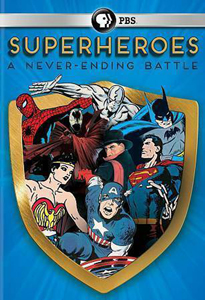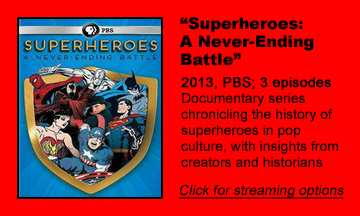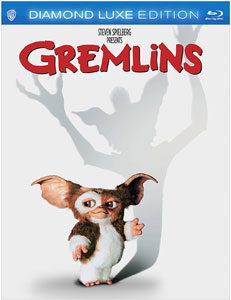If you’re a fan of superheroes thanks to the 2010s cinema boom and are curious about their history in comics, “Superheroes: A Never-Ending Battle” (2013), a three-part PBS documentary, is a nice overview. Hosted by Liev Schreiber (Sabretooth in the “Wolverine” films), it’s aimed at a wide audience in a somewhat academic tone, but I – as a mid-level superhero/comics fan – learned several tidbits and had fun watching it.
Starting with Superman
The documentary starts with the twin inventions of Superman and the comic-book format in the 1930s, only briefly mentioning precursors like The Shadow and the comic-strip format – cueing us that it doesn’t have time for everything.
Superman, Batman and Wonder Woman all have richly controversial origins – creator credit/pay in the first two cases, and roots in soft-core bondage porn in the latter – but those are skimmed over. (Check out “Batman & Bill” and “Robert Kirkman’s Secret History of Comics” for a full dive.)
“Superheroes” doesn’t chronicle the release of every big title, instead leaning toward moments that made wide pop-culture splashes — such as a 1960s “Green Lantern”/ “Green Arrow” crossover about racial issues and the assassinations of King and the Kennedys.
It hits on how the real world influenced comics (Captain America punching Hitler during WWII) and vice versa (Spider-Man providing a role model for teens who feel like outsiders). It touches on sea changes in artistry, like Jack Kirby’s kinetic action and Carmine Infantino’s no-dialog pages in “Nick Fury.”
Interviews with legends
“Superheroes” features interviews with numerous legends, and it’s nice to put faces to the names. The most familiar face, the late Stan Lee, gives us slightly more than his usual gee-wiz shtick when he tells of how his “Spider-Man” anti-drug issue broke the back of the Comics Code Authority.
It would be nice to get more perspectives from females and minorities; only one woman artist from the early days is briefly interviewed. Granted, it was a white-male-dominated industry, and we at least get diverse POVs of historians, including a black man who was excited when Spider-Man says hi to a black student in the 1960s.
The production is a visual treat, as the docu has access to old photos from inside the offices of Marvel and DC. It supplements these with lightly animated and narrated comic panels, although it’s jarring to hear Adam West narrating “The Dark Knight Returns.” The docu is otherwise smart enough to understand the difference between campy Batman and Dark Knight Batman.
One topic where it misleads a casual fan is “X-Men’s” creation. The “X-Men” chatter is in episode three, amid coverage of the modern cinema boom. An uninformed viewer will think the X-Men were created three decades later than they were.
In and out of the mainstream
“Superheroes” mentions the oddity wherein comics and their accompanying mainstream presentations (radio dramas, TV serials, and now blockbuster films) don’t always reach audiences at the same rate. For example, superhero flicks are huge this century, but comics are selling at a historically low rate.
Compare this to the 1940s, when 90 percent of children and teens of both genders read comics. The documentary presents no theory for this quirk, nor can it answer the question of whether superheroes climbed in popularity or everyone finally admitted they liked the genre.
The docu closes with an observation by “Spawn’s” Todd McFarlane that video games will soon be the dominant form of entertainment– something my friend who is a third-grade teacher also sees coming. McFarlane says we shouldn’t be worried about games or digital comics, because only the delivery mechanism is changing.
Video games will be the fourth chapter in this documentary if it’s expanded. For now, “Superheroes: A Never-Ending Battle” brings us up to date in engaging fashion.



